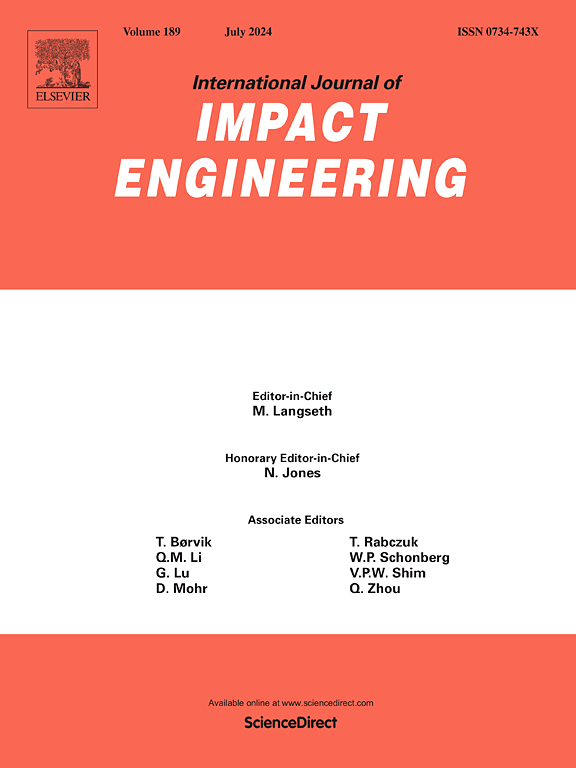Effect of pre-shock on the expanding fracture behavior of 1045 steel cylindrical shell under internal explosive loading
IF 5.1
2区 工程技术
Q1 ENGINEERING, MECHANICAL
International Journal of Impact Engineering
Pub Date : 2024-11-12
DOI:10.1016/j.ijimpeng.2024.105183
引用次数: 0
Abstract
Explosively driven expansion fractures in metallic shells will be preceded by a compression shock wave, which inevitably changes the mechanical and microstructural state of the shell materials and thus affects their subsequent dynamic deformation and expansion fracture processes. To understand the influence of pre-shock pressure on the dynamic expansion fracture behavior of metallic shells, the incident shock waves with varying peak pressure were generated in a 1045 steel cylindrical shell by sweeping detonation wave loading. The pre-shock and subsequent expansion fracture processes were continuously diagnosed by combining a high-speed framing camera and the arrayed Photon Doppler Velocimetry (PDV) measurements to obtain the fracture strains at different axial positions (corresponding to different pre-shock pressures). The results clearly show that the pre-shock pressure during detonation loading has a significant effect on the expansion fracture properties of the 1045 steel cylinder; the fracture strain remarkably decreases with the increase of pre-shock pressure from ∼19 GPa to ∼20 GPa and then changes gently in the range of ∼20 GPa to ∼22 GPa. Metallurgical analyses reveal increased densities of microstructural defects, including dislocations and deformation twins, when a shock wave passes through, resulting in a reduced capacity for further defect storage in the shocked metals, ultimately leading to a decrease in the fracture strain during the subsequent expansion deformation process.
预冲击对内部爆炸加载下 1045 钢圆柱形外壳膨胀断裂行为的影响
金属壳体在爆炸驱动膨胀断裂之前会产生压缩冲击波,这不可避免地会改变壳体材料的力学和微观结构状态,从而影响其后续的动态变形和膨胀断裂过程。为了了解冲击前压力对金属壳体动态膨胀断裂行为的影响,我们通过扫频爆轰波加载在 1045 钢圆柱形壳体中产生了不同峰值压力的入射冲击波。通过高速取景相机和阵列式光子多普勒速度测量仪(PDV)测量,获得不同轴向位置(对应不同冲击前压力)的断裂应变,从而对冲击前和随后的膨胀断裂过程进行连续诊断。结果清楚地表明,爆轰加载时的预震压力对 1045 钢圆柱体的膨胀断裂性能有显著影响;断裂应变随着预震压力从 ∼19 GPa 到 ∼20 GPa 的增加而显著减小,然后在 ∼20 GPa 到 ∼22 GPa 范围内平缓变化。冶金分析表明,当冲击波通过时,微结构缺陷(包括位错和变形孪晶)的密度增加,导致冲击金属中进一步储存缺陷的能力降低,最终导致在随后的膨胀变形过程中断裂应变降低。
本文章由计算机程序翻译,如有差异,请以英文原文为准。
求助全文
约1分钟内获得全文
求助全文
来源期刊

International Journal of Impact Engineering
工程技术-工程:机械
CiteScore
8.70
自引率
13.70%
发文量
241
审稿时长
52 days
期刊介绍:
The International Journal of Impact Engineering, established in 1983 publishes original research findings related to the response of structures, components and materials subjected to impact, blast and high-rate loading. Areas relevant to the journal encompass the following general topics and those associated with them:
-Behaviour and failure of structures and materials under impact and blast loading
-Systems for protection and absorption of impact and blast loading
-Terminal ballistics
-Dynamic behaviour and failure of materials including plasticity and fracture
-Stress waves
-Structural crashworthiness
-High-rate mechanical and forming processes
-Impact, blast and high-rate loading/measurement techniques and their applications
 求助内容:
求助内容: 应助结果提醒方式:
应助结果提醒方式:


